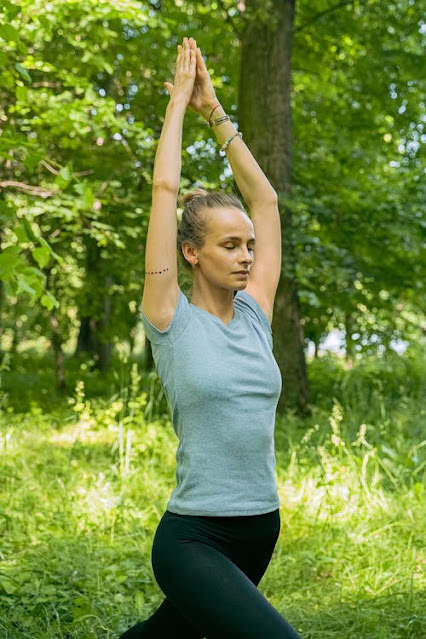Yoga is one
of the best ways to stay calm and to fight the symptoms of illness or illness
early.
Yoga
incorporates a variety of postures, mudras, pranayama, and meditation that work
carefully on every muscle and joint in its entirety. It will relieve stiffness,
make you more flexible, improve the functioning of various organs, improve the
nervous system, work in the joints, and focus on mental health.
All of the
above are important for better protection. By improving the functioning of the
heart, lungs, stomach, intestines, kidneys, liver, and oxygen supply, your
immune system is strengthened. This helps you to fight germs and germs that can
be harmful to your health.
How does
yoga improve the immune system?
With
consistent yoga practice, you will gradually begin to notice the improvement in
your flexibility and mobility. Muscle strength will decrease which will
strengthen your muscles. Your members will be anointed leading to a better
move.
Baby Yoga
also promotes better function of vital organs and removes toxins through new
supply of blood and oxygen as well as body massage to promote better functioning.
Your immune
system is also affected by the weakening of the respiratory system. When you do
yoga, you are not only opening your chest and lungs but also paying attention
to your breathing. This helps to increase the elasticity and strength of the lungs,
leading to a better immune system.
Finally, when your body is functioning properly, your brain will also function properly. Depression symptoms that are transmitted to various parts of the body and organs release hormones that increase stress. This is also one of the main reasons why the immune system is weakened. Yoga will help to soothe your mind, release happiness hormones, and create a healthy immune system.
What does
science say?
The study
was conducted on 60 first-year MBBS students (divided into 30 control groups
and 30 yoga group). They were tested for various parameters such as depression
level, blood pressure, etc. which is a result of the test stress.
After the
yoga group performed 12 weeks of daily 35 infant yoga exercises, it was noted
that yoga groups had significant lowering of blood pressure and lower levels of
stress. While cortisol increased in both groups, it was much lower in the yoga
group.
This also
proves that practicing yoga helps to build better immune systems that are able
to withstand the changes brought about by the pressure of the test.
A review of
15 randomized controlled trials (RCTs) was published in 2018 which saw that
yoga could be recommended as a “complementary intervention”. It was noted that
the long-term practice of yoga helped to reduce the risk of inflammation and
inflammation of the joints.
Another
review of the journal saw how regular yoga practice for 4 weeks increased the
immune system to fight infections and infections. It can support people of all
ages by strengthening their immune system.
6 Yoga is a
baby to improve immunity
Below are 6
active yoga exercises to strengthen your immune system.
Triangle
Pose (Trikonasana)
Practicing a
triangle will strengthen your arms, shoulders, chest, legs, and spine. It will
also help reduce stress and anxiety, improve concentration and improve balance.
Your blood circulation will increase to the upper part of the body.
Stand at Tad
asana (Mountain Pose) with your feet 3–4 meters apart.
Your right
foot should be directed towards the short end of the mat and the heels should
be aligned. Stretch your arms out to the side, in line with the mat, with your
palms facing down.
Start
bending to your right foot from your hips, lowering your right arm down and
your left arm upwards.
Bend until
your fingers touch your right foot or ankle. You can also use a yoga block on
its upper side to relax your right hand.
Turn your
head to look at your left fingers.
Hold this
position for 5 breaths and repeat with the other leg.
Standing
Forward Fold (Uttanasana)
Uttanasana
promotes circulation to the brain by bringing it down to the heart. It relieves
sinus congestion, stimulates the digestive system, expands the spine, and helps
deal with insomnia, depression, and anxiety.
Stand in
Tad asana (Mountain Pose) legs slightly apart.
Stretch your
arms out and bend gently from your hips. Keep the microband on the knees so
that your hands touch the mat. Or use a yoga block to relax your hands.
Hang your
head freely and keep this position for 3-5 breaths.
Cobra Pose
(Bhujanasana)
Cobra pose
stretches your upper body and provides relief from back pain. It helps you deal
with many respiratory problems and stretching your spine, adjusting your
posture, and improving your mood by relieving stress and fatigue.
Lie on your
stomach and place your arms next to your ribs.
Bring your
hands under your shoulders and spread your fingers to create a strong support
and spread the weight evenly.
Put a small
weight on your hands, lift your head and chest up while keeping your pelvis and
legs in place.
Your arms
should be relaxed but they should support your upper body weight by bending
slightly at your elbows.
Sit in this
position for 10-15 seconds and then return gently to relax your body on the
mat.
Child
Position (Bal as a)
The baby's
posture is a very relaxing condition that works throughout the body. It
relieves back pain, promotes calm sleep, works on the abdominal muscles and
hips, stretches and tightens the shoulders, and expands your spine.
Sit in the
Vajrayana (Thunderbolt Pose) with your toes tied. Your big toes should touch
and the buttocks should be placed on the heels.
Put your
arms in front of you with your hands touching the mat.
Create a
small gap between the knees and bend forward from your waist. If possible, put
your forehead on the floor or relax it in a yoga block.
Hold this
stop for 3-5 breathes
